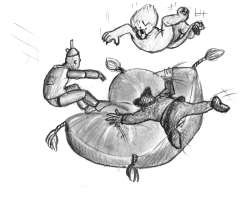

This tutorial shows how to write efficient and robust distributed applications with the Mozart programming system. We first present and motivate the distribution model and the basic primitives needed for building distributed applications. We then progressively introduce examples of distributed applications to illustrate servers, agents, mobility, collaborative tools, fault tolerance, and security.
The tutorial is suitable for Oz programmers who want to be able to quickly start writing distributed programs. The document is deliberately informal and thus complements the other Oz tutorials and the research papers on distribution in Oz.
The Mozart programming system has been developed by researchers from DFKI (the German Research Center for Artificial Intelligence), SICS (the Swedish Institute of Computer Science), the University of the Saarland, UCL (the Université catholique de Louvain), and others.
Warning: THE MATERIAL IN THIS DOCUMENT IS INCOMPLETE. THIS DOCUMENT WILL EVENTUALLY BE SUPERSEDED BY A COMPLETE DOCUMENT. IN THE MEANTIME, WE RECOMMEND LOOKING AT THE DISTRIBUTED PROGRAMMING (DP) CATEGORY OF THE MOGUL ARCHIVE AND READING CHAPTER 11 OF THE BOOK 'CONCEPTS, TECHNIQUES, AND MODELS OF COMPUTER PROGRAMMING'.
| A | B | C | D | E | F | G | H | I | J | L | M | N | O | P | R | S | T | U | V | W |
Connection module: 1 IntroductionConnection moduleDPannotate: 3.2.4 Making stationary objects, the new waygetFaultStream: 4.2.1 The fault streamConnection module: 3.1.1 Connecting applications by means of ticketsPickle module: 3.1.2 Persistent data structures by means of picklesRemote module: 3.1.3 Remote computations and functorslocalFail: 4.1 Fault statesok: 4.1 Fault statespermFail: 4.1 Fault statestempFail: 4.1 Fault statesDP.getFaultStream: 4.2.1 The fault streamlocalFailCell: 2.1.5 Sited entitiesFloat: 2.1.5 Sited entitiesInt: 2.1.5 Sited entitiesList: 2.1.5 Sited entitiesLock: 2.1.5 Sited entitiesNumber: 2.1.5 Sited entitiesPort: 2.1.5 Sited entitiesProcedure: 2.1.5 Sited entitiesRecord: 2.1.5 Sited entitiesApplication: 2.1.5 Sited entitiesBrowser: 2.1.5 Sited entitiesConnection: 2.1.5 Sited entitiesConnection: 1 IntroductionDP: 1 IntroductionFD: 2.1.5 Sited entitiesModule: 2.1.5 Sited entitiesOpen: 2.1.5 Sited entitiesOS: 2.1.5 Sited entitiesPickle: 2.1.5 Sited entitiesPickle: 1 IntroductionProperty: 2.1.5 Sited entitiesRemote: 2.1.5 Sited entitiesRemote: 1 IntroductionSearch: 2.1.5 Sited entitiesTk: 2.1.5 Sited entitiesokpermFailPickle module: 1 IntroductionPickle moduleRemote module: 1 IntroductionRemote moduletempFailfinal in Java: 2.1.3 Single-assignment entities